
Poaceae or Gramineae is a large and nearly ubiquitous family of monocotyledonous flowering plants known as grasses. It includes the cereal grasses, bamboos and the grasses of natural grassland and species cultivated in lawns and pasture. The latter are commonly referred to collectively as grass.

In botany and dendrology, a rhizome is a modified subterranean plant stem that sends out roots and shoots from its nodes. Rhizomes are also called creeping rootstalks or just rootstalks. Rhizomes develop from axillary buds and grow horizontally. The rhizome also retains the ability to allow new shoots to grow upwards.

Herbaceous plants are vascular plants that have no persistent woody stems above ground, including many perennials, and nearly all annuals and biennials. Herbaceous plants include graminoids, forbs, and ferns. Forbs are generally defined as herbaceous broad leafed plants, while graminoids are plants with grass-like appearance including the true grasses, sedges, and rushes. In some botanical sources, the noun "herb" refers to a "plant that does not produce a woody stem", and the adjective "herbaceous" means "herb-like", referring to parts of the plant that are green and soft in texture". The word "herb" has also other meanings in cooking, medicine, and other fields.
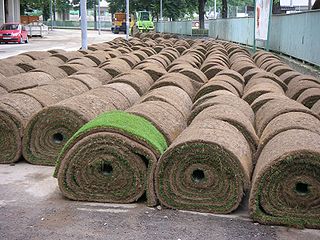
Sod, also known as turf, is grass. When harvested into rolls it is held together by its roots and a thin layer of soil.
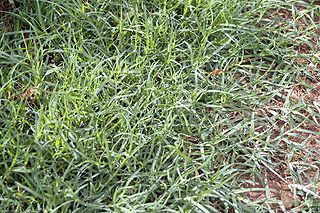
Cynodon dactylon, known as Bermuda grass, Dhoob, dūrvā grass, ethana grass, dubo, dog's tooth grass, Bahama grass, devil's grass, couch grass, Indian doab, arugampul, grama, wiregrass and scutch grass, is a grass now found worldwide. It is native to Europe, Africa, Australia and much of Asia. It has been introduced to the Americas. Although it is not native to Bermuda, it is an abundant invasive species there. In Bermuda it has been known as crab grass.
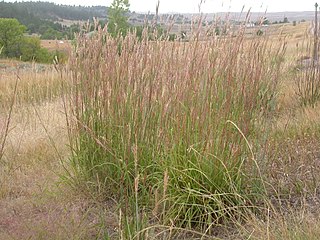
Andropogon gerardi, known commonly as big bluestem, tall bluestem, bluejoint, and turkeyfoot, is a species of tall grass native to much of the Great Plains and grassland regions of central and eastern North America.

Aegilops is a genus of Eurasian and North American plants in the grass family, Poaceae. They are known generally as goatgrasses. Some species are known as invasive weeds in parts of North America.

Nepenthes gymnamphora is a tropical pitcher plant native to the Indonesian islands of Java and Sumatra. It has a wide altitudinal range of 600–2,800 metres (2,000–9,200 ft) above sea level. There is much debate surrounding the taxonomic status of this species and the taxa N. pectinata and N. xiphioides.

Astrebla is a small genus of xerophytic grasses found only in Australia. They are the dominant grass across much of the continent. They are commonly known as Mitchell grass after Scottish explorer, Thomas Mitchell, who first collected a specimen near Bourke in New South Wales.

The gibberbird is a species of chat within the passerine birds.

Stuckenia pectinata, commonly called sago pondweed or fennel pondweed, and sometimes called ribbon weed, is a cosmopolitan water plant species that grows in fresh and brackish water on all continents except Antarctica.

Mallee Woodlands and Shrublands is one of 32 Major Vegetation Groups defined by the Australian Government Department of the Environment and Energy.
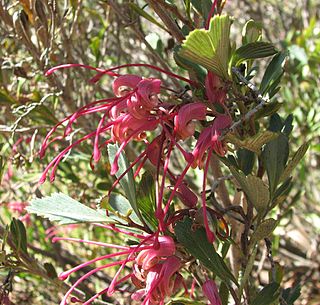
Grevillea pectinata, commonly known as comb-leaf grevillea, is a shrub in the family Proteaceae. It is endemic to the south-west of Western Australia.

Spartina pectinata is a species of cordgrass known as prairie cordgrass, freshwater cordgrass, tall marshgrass, and sloughgrass. It is native to much of North America, including central and eastern Canada and most of the contiguous United States except for the southwestern and southeastern regions. Its distribution extends into Mexico. It is also present on other continents as an introduced species.

Cycas pectinata was the fourth species of Cycas to be named; it was described in 1826 by Scottish surgeon and botanist Francis Buchanan-Hamilton from Kamrup, Assam in northeast India. The species is one of the most widespread cycads. It is found in the northeastern part of India, Nepal, Bhutan, northern Burma, southern China (Yunnan), Bangladesh, Burma, Malaysia, Cambodia, northern Thailand, Laos, and Vietnam. Cycas pectinata usually grow at elevation 300 m to 1200 m and in difficult terrains. In China, it grows in dry, open thickets in limestone mountains, red soil in sparse monsoon forests. Cycas pectinata grows up to 40 feet (12 m) tall and has very large, ovoid male cones. The tallest Cycas pectinata is a female plant in North Kamrup, Assam which measures 52.8 feet (16.1 m). The tree is the world's tallest Cycas plant. In Northeast India, the species is under severe threat due to clearing of forest and over collection of male cones for preparation of traditional medicines. The species is listed in CITES Appendix II and IUCN Redlist.

Eucalyptus ochrophloia, commonly known as the yapunyah, is a species of eucalypt native to inland New South Wales and Queensland in eastern Australia.

Eucalyptus odontocarpa, commonly known as Sturt Creek mallee, is a mallee that is native to northern Australia. Indigenous Australians know the plant as Warilyu.

Astrebla elymoides, commonly known as hoop Mitchell grass, is a herb of the family Poaceae. Named in honour of Thomas Mitchell, it is regarded as the best of the Astrebla grasses for grazing, particularly for cattle. Often seen growing to one metre tall, on floodplains and heavy self mulching clay soils in arid to semi arid Australia. Flowering is in response to rain or flooding.
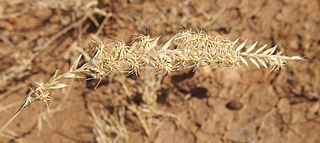
Astrebla squarrosa, commonly known as bull Mitchell grass, is a long lived herb of the family Poaceae. Named in honour of Thomas Mitchell, it is regarded as the most flood tolerant of the Astrebla grasses. Often seen growing to 1.5 metres tall, on floodplains and heavy dark clay soils in arid to semi arid Australia. The coarse stems and difficult digestibility make this a less desirable Mitchell grass for livestock. Flowering is in response to rain.



















